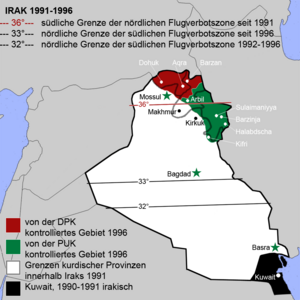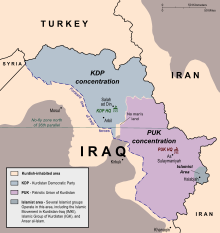DPK-PUK conflict

Situation on the eve of the Iraqi intervention in the Kurdish region in 1996 (Erbil under the control of the PUK)
| date | May 1994 to November 24, 1997 |
|---|---|
| place | Kurdistan Autonomous Region |
| output | |
| consequences | Armistice ; Creation of two Kurdish administrations (In Erbil and Sulaimaniya ) |
| Peace treaty | Washington Agreement |
| Parties to the conflict | |
|---|---|
| Commander | |
| Troop strength | |
| losses | |
| 5,000 dead | |
The DPK-PUK conflict ( Kurdish : Birakujî = fratricide ) was a military conflict between the rival Kurdish organizations Democratic Party of Kurdistan (DPK) and Patriotic Union of Kurdistan (PUK) in the autonomous region of Kurdistan in the mid-1990s. In the course of the fighting Kurdish organizations from Iran and Turkey as well as Iranian, Iraqi and Turkish troops became involved in the conflict.
background
According to an agreement between the Iraqi government and leaders of the Iraqi Kurds, an autonomous zone was established in March 1970 in the Kurdish part of Iraq under the name Kurdish Autonomous Region . The autonomous parliament was established in Erbil and was theoretically the authority over the provinces of Erbil , Dahuk and as-Sulaimaniya . Despite the autonomy, there were repeated clashes between the Kurds and the government in Baghdad until after the end of the Second Gulf War in 1991, a no-fly zone was set up by UN Security Council resolution 688 under the name Safe Haven . Since the zone only covered part of the Kurdish area, clashes continued in Sulaimaniya and Kirkuk . After a while, an uncertain equilibrium arose, whereupon the Iraqi government withdrew its military and civilian personnel in October 1991. This gave the region de facto independence and was ruled by the two Kurdish parties DPK and PUK. The Kurdish rulers soon introduced their own flag and national anthem ( Ey Reqîb ). Elections to the Kurdish Parliament were held on May 19, 1992. The seats were divided equally between the DPK and the PUK.
Baghdad had placed an economic embargo on the region and reduced imports of oil and food. The Kurdish economy suffered badly from this embargo, as Iraq was still under a UN embargo, so that the Kurds could not trade with neighboring countries. Because of this double embargo, all trade in the region took place only on the black market . The two parties fought each other over control of the smuggling routes.
Beginning of Fights (1994)
Open fighting broke out between the two parties in May 1994, killing 300 people. 2000 people were killed on both sides during the next year. According to CIA agent Robert Baer , the Iranian Revolutionary Guard supported the DPK and allowed them to attack from Iranian territory.
Fights Again (1996)
Although the Kurdish parliament closed its meetings in May 1995, the fragile ceasefire between the PUK and DPK lasted until summer 1996. Talabani concluded an alliance with Iran and supported it on July 28 in an attack on Iraqi soil against the Kurdistan Democratic Party -Iran.
Faced with Iran and the PUK, Masud Barzani asked Saddam Hussein for support. He saw the opportunity to retake Northern Iraq and agreed. On August 31, DPK fighters and 30,000 Iraqi soldiers led by a tank division of the Republican Guard attacked the city of Erbil, which was held by 3,000 PUK fighters under Korsat Rasul Ali. After the city was captured, 700 PUK fighters and members of the Iraqi National Congress were executed outside the city.
This attack reinforced US fears that Saddam Hussein would launch a genocide campaign against the Kurds, similar to the Anfal operation of 1988 and the 1991 campaigns. Saddam Hussein's move was also a clear violation of UN Security Council Resolution 688 against the oppression of the ethnic minorities in Iraq. In response, US forces began Operation Desert Strike in the region on September 3, and US ships and Boeing B-52 bombers fired 27 cruise missiles at Iraqi air defenses in southern Iraq. The next day, 17 more cruise missiles were launched by American ships against Iraqi air defenses. The US is moving warplanes and an aircraft carrier into the Persian Gulf, the southern no-fly zone has been extended north to the 33rd parallel north.
After the DPK came to power in Erbil, Iraqi troops from the Kurdish region withdrew to their original positions. The DPK drove the PUK out of their strongholds and took Sulaimaniya with Iraqi help. Jalal Talabani and the PUK withdrew to the Iranian border, and American forces evacuated 700 members of the Iraqi National Congress and 6,000 pro-Western Kurds from northern Iraq.
Intervention of Turkey (1997)
The fighting between the DPK and the PUK lasted all winter 1996/7. To make matters worse, the anti-Turkish Kurdistan Workers' Party (PKK) had withdrawn to northern Iraq. Allied with the PUK, the PKK began to attack ethnic Assyrians and DPK supporters. In response to this, the Turkish armed forces tried in May 1997 with Operation Hammer (tr .: Çekiç Harekâtı) to destroy the PKK in northern Iraq. Although Operation Hammer inflicted heavy losses on the PKK, it continued to operate in northern Iraq.
On September 25th, Turkish troops entered Northern Iraq again (tr .: Şafak Harekâtı; Operation Dawn). This time they were allied with the DPK and attacked positions of the PUK and the PKK in order to force a ceasefire between the PUK and the DPK. The operation again led to heavy losses for the PKK, and a ceasefire was negotiated between the PUK and DPK.
Despite the ceasefire, new fighting flared up along the ceasefire line between the DPK and PUK in October and November. 1,200 fighters were killed on both sides and 10,000 civilians had to flee their homes. A permanent armistice was finally agreed on November 24th.
Effects
On September 17, 1998, Masud Barzani and Jalal Talabani signed the US-brokered peace agreement in Washington. The key points of the agreement are the cessation of the fighting, the formation of a common government, the preparations for elections in 1999 and the retreat of the PKK beyond the border with Turkey. The USA committed itself to using military means to protect the Kurds against Saddam Hussein. At the same time, the UN's oil-for-food program increased income and living standards in the region. Iraqi Kurdistan became a relatively peaceful region until the Kurdish Islamist group Ansar al-Islam emerged in 2001 and new fighting broke out.
About a month later, US President Bill Clinton issued the Iraq Liberation Act , which promised military aid to opposition Iraqi groups.
The DPK estimates that between October 1996 and October 1997 58,000 of its supporters were evicted from the PUK areas. The PUK speaks of 49,000 PUK supporters displaced in the period from August 1996 to December 1997. Despite the agreement, the Kurdish area was in fact divided into two parts. There were two administrations in Erbil (DPK) and Suleimaniya (PUK). New elections were not held until 2005.
The DPK and PUK later supported the US and its allies in the 2003 Iraq war by driving Iraqi troops out of the north and taking cities like Mosul and Kirkuk. After the US invasion , Masud Barzani was elected President of the Kurdish region and Jalal Talabani was elected President of Iraq.
Individual evidence
- ↑ a b Michael G. Lortz: Willing to Face Death: A History of Kurdish Military Forces. The Kurdish Civil War (1995-1998). (No longer available online.) In: THE FLORIDA STATE UNIVERSITY, COLLEGE OF SOCIAL SCIENCES. Florida State University Libraries, 2005, p. 63 , archived from the original on Oct. 29, 2013 ; Retrieved on December 21, 2015 (English, A thesis submitted to the Department of International Affairs in partial fulfillment of the requirements for the degree of Master of Arts). Info: The archive link was inserted automatically and has not yet been checked. Please check the original and archive link according to the instructions and then remove this notice.
- ↑ http://www.atimes.com/atimes/Middle_East/LB20Ak02.html
- ^ L. Fawcett, Down but not out? The Kurds in International Politics , Reviews of International Studies, Vol. 27, 2001 p. 117
- ↑ a b c d The Kurds by David Plotz , article on www.slate.com from September 1996
- ↑ M. Leezenberg, Iraqi Kurdistan: contours of a post-civil war society , Third World Quarterly, Vol 26, No. 4-5, June 2005, pp 636th.
- ↑ a b c http://www.globalsecurity.org/military/world/para/kdp.htm
- ↑ http://www.globalsecurity.org/military/world/para/kdpi.htm
- ↑ http://www.globalsecurity.org/military/ops/desert_strike.htm
- ↑ a b c http://www.globalsecurity.org/military/world/para/puk.htm
- ^ Azad Salih: Free Kurdistan. The protection zone of the Kurds in Iraqi Kurdistan , dissertation at the Free University of Berlin, 2004, p. 166
- ↑ http://www.thewashingtoninstitute.org/templateC05.php?CID=1219
bibliography
- Robert Baer : The Downfall of the CIA. A CIA agent's investigation report . Bertelsmann-Verlag, Munich 2002, 418 pages, ISBN 3-570-00676-X
- Kenneth Pollack: The Threatening Storm: The Case for Invading Iraq . Random House, 2002, ISBN 0375509283 .
- Azad Salih: Free Kurdistan. The protection zone of the Kurds in Iraqi Kurdistan , dissertation at the Free University of Berlin, 2004, 12 chapters, pdf; with a detailed, slightly DPK-oriented description of the conflict
